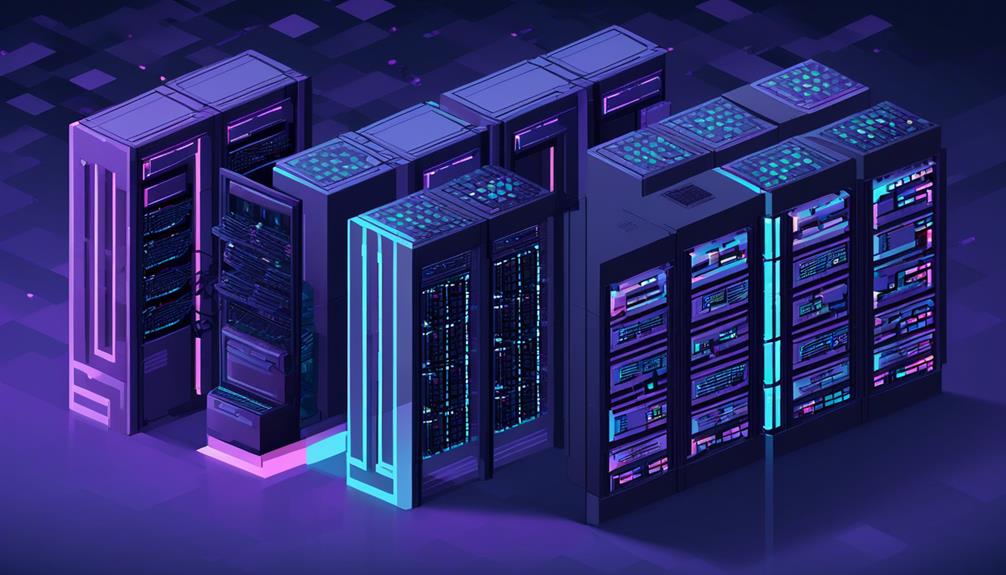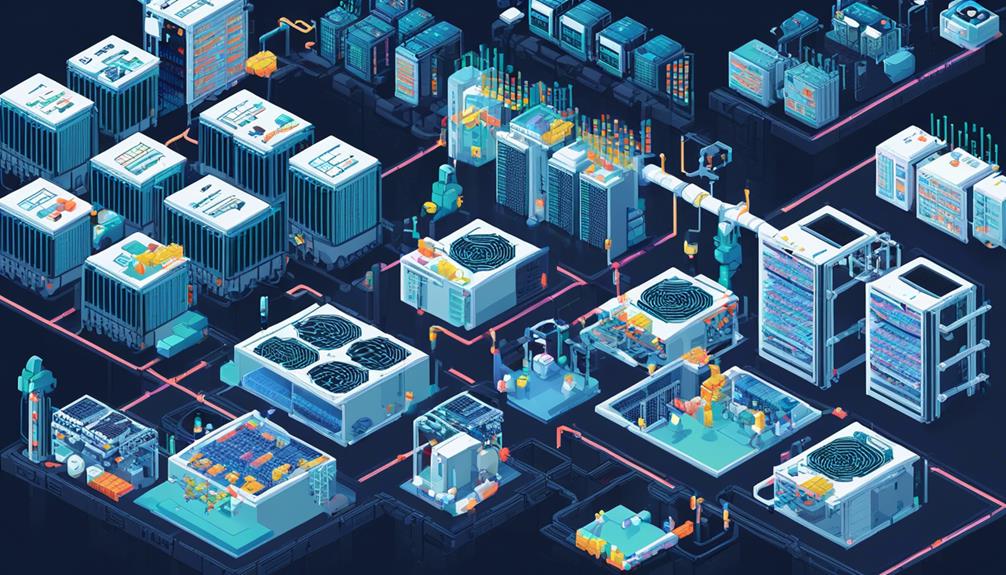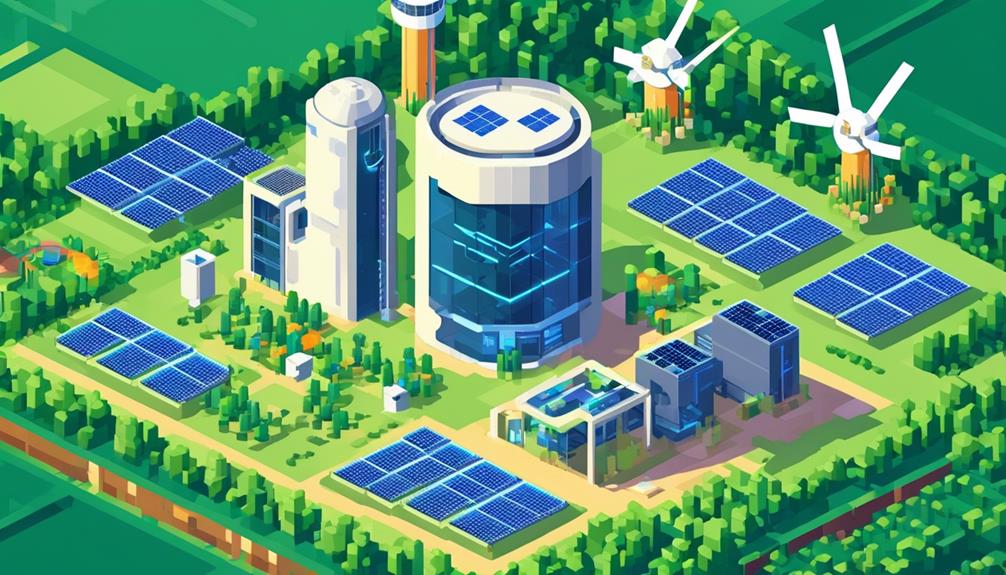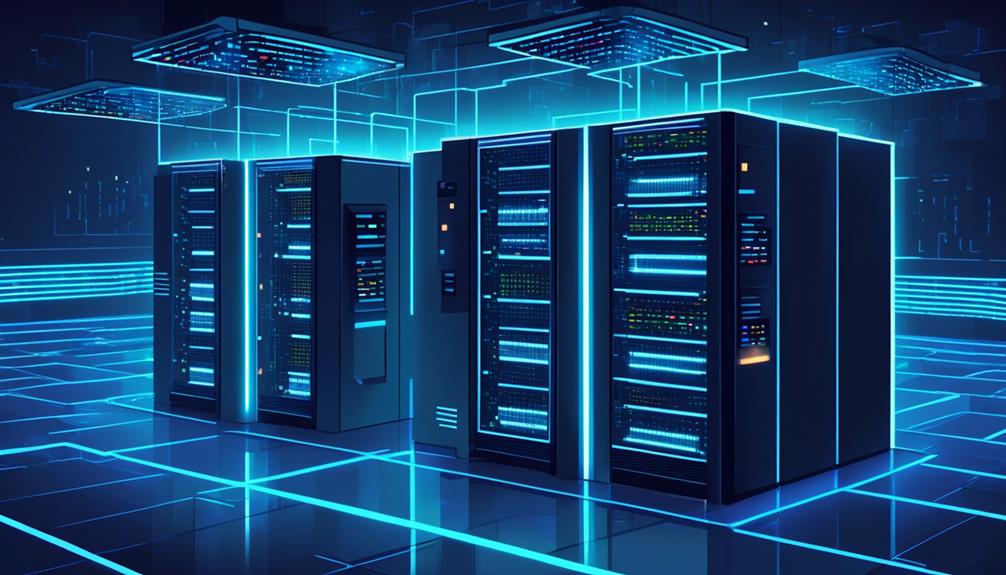As the demand for data processing and storage continues to grow exponentially, data centers are faced with the challenge of meeting this demand while minimizing their environmental impact. This is where AI comes into play.
By leveraging advanced machine learning algorithms and real-time monitoring capabilities, AI has the potential to revolutionize energy efficiency in data centers. From optimizing power and cooling systems to identifying and addressing sub-optimal equipment performance, AI offers a range of solutions that can significantly reduce energy consumption and improve overall sustainability.
In this discussion, we will explore the various ways in which AI is transforming data centers into more energy-efficient and eco-friendly environments, paving the way for a greener future in the digital age.
Key Takeaways
- AI optimizes hardware and energy efficiency in data centers by analyzing temperature data and adjusting cooling systems, leading to significant energy savings.
- AI-driven robots automate tasks such as inventory management, equipment maintenance, and monitoring, reducing the need for human intervention and increasing operational efficiency.
- AI enables real-time dynamic optimization of data center environments by continuously analyzing data and making adjustments to optimize energy efficiency.
- AI contributes to the development of green data centers by promoting energy efficiency, reducing the carbon footprint, and enhancing overall sustainability.
AI-Optimized Hardware for Energy Efficiency

AI-optimized hardware plays a crucial role in reducing energy consumption in data centers, making it an essential component for achieving energy efficiency. With the increasing demand for data processing and storage, data centers have become significant consumers of energy. However, AI has emerged as a promising solution to address this challenge by optimizing hardware and reducing energy consumption.
AI tools have proven to be effective in saving power spent on data center cooling. By using advanced algorithms and machine learning, AI can analyze temperature data and adjust cooling systems accordingly. This dynamic optimization allows for more efficient cooling, leading to significant energy savings. In fact, studies have shown that AI tools can save up to 40% of the power spent on data center cooling.
Furthermore, AI-powered robots are being utilized to automate functions and optimize efficiency in data centers. These robots can perform tasks such as inventory management, equipment maintenance, and monitoring. By automating these processes, AI reduces the need for human intervention and increases operational efficiency, resulting in reduced energy consumption.
Another significant aspect of AI in data centers is its ability to enable real-time dynamic optimization. AI algorithms can continuously analyze data center conditions, such as server loads and ambient temperature, and make adjustments in real-time to optimize energy efficiency. This dynamic optimization ensures that resources are utilized efficiently and minimizes energy wastage.
In addition, AI allows for intuitive management of cooling units to match the load they are serving, leading to optimal efficiency. By analyzing data from various sources, including server workloads and environmental conditions, AI can determine the precise cooling requirements and adjust cooling units accordingly. This intelligent management ensures that cooling systems operate at their optimal capacity, reducing energy consumption while maintaining optimal server performance.
AI-Driven Energy-Saving Practices
With its ability to optimize hardware, automate tasks, and enable real-time dynamic optimization, AI offers a range of energy-saving practices in data centers. One of the significant energy-saving practices is the use of AI to control cooling equipment. By utilizing sensors and machine learning algorithms, AI can optimize the cooling process, resulting in up to 40% savings in power spent on data center cooling. This real-time control ensures that cooling equipment operates at optimal levels, reducing energy consumption and improving data center efficiency.
Another energy-saving practice enabled by AI is the use of digital twin technology. By leveraging AI and machine learning, digital twin models can optimize facility design and space utilization in data centers. This optimization leads to reduced energy consumption by maximizing the efficiency of the available space and ensuring that resources are utilized effectively.
Furthermore, AI-driven robots play a crucial role in automating various tasks in data centers. These robots can perform tasks such as server upgrades, monitoring, and maintenance, improving the overall efficiency of data center operations. By automating these tasks, AI reduces the reliance on human intervention, minimizing errors, and optimizing energy usage.
Predictive analytics, powered by AI, also contributes to energy-saving practices in data centers. Through the analysis of historical data and real-time monitoring, AI can predict future energy consumption patterns and identify opportunities for optimization. By leveraging these insights, data center operators can make informed decisions to reduce energy consumption and overall costs.
Lastly, AI enables dynamic optimization of data center environments in real time. By continuously monitoring and adjusting various parameters such as temperature, airflow, and workload distribution, AI ensures that data center resources are utilized efficiently. This dynamic optimization leads to improved performance, cost savings, and overall operational efficiency.
Benefits of AI in Data Center Efficiency

AI plays a crucial role in maximizing data center efficiency through several key functions.
- Dynamic Optimization: AI enables real-time optimization of data center environments, leading to improved performance, cost, and operation. By continuously analyzing data and adjusting parameters, AI algorithms can optimize the utilization of servers and resources, ensuring efficient workload distribution and reducing energy waste.
- Intuitive Management of Cooling Units: AI enables intelligent management of cooling units to match the load they are serving. By monitoring temperature and other environmental factors, AI systems can adjust cooling settings in real time, ensuring proper temperature maintenance without excessive energy consumption. This not only saves energy but also reduces cooling costs.
- Enhanced Energy Efficiency: AI can optimize the operation of cooling units by reducing the speed of lightly loaded units and increasing the effort of heavily loaded units. By dynamically adjusting fan speeds and other parameters, AI algorithms ensure that cooling resources are allocated efficiently, resulting in better energy efficiency and reduced power consumption.
- Predictive Maintenance: AI enables constant monitoring of equipment in the data center and quick notification of cooling issues. By analyzing performance data and identifying patterns, AI systems can detect potential problems before they escalate, allowing for timely maintenance and minimizing downtime. This proactive approach to maintenance enhances operational efficiencies and reduces costs.
AI's Contribution to Green Data Centers
The implementation of artificial intelligence (AI) technologies in data centers has significantly contributed to the development of green data centers, promoting energy efficiency and sustainability. AI and machine learning (ML)-based digital twins play a crucial role in reducing data centers' carbon footprint by optimizing facility design and space utilization. By simulating the physical infrastructure and operations of data centers, AI-powered digital twins can identify potential areas for improvement in energy efficiency.
Real-time control of cooling equipment is another area where AI contributes to green data centers. By using sensors and ML algorithms, data centers can reduce the energy spent on cooling. These technologies enable the optimization of cooling systems based on the actual temperature and load requirements, ensuring efficient cooling without unnecessary energy consumption.
AI-powered robots are also being deployed in data centers to automate functions and optimize efficiency. These robots can perform tasks such as equipment maintenance, inventory management, and even server deployment, reducing human intervention and energy consumption. Consequently, the use of AI-powered robots leads to lower energy consumption and overall costs in data centers.
Furthermore, AI enables dynamic optimization of data center environments in real time. By continuously analyzing data and making adjustments, AI systems can improve the performance, cost, and operation of data centers. For example, AI algorithms can intuitively manage cooling units to match the load they are serving, resulting in optimal efficiency.
Harnessing AI for Sustainable Data Centers

Harnessing the power of artificial intelligence (AI) in data centers is essential for achieving sustainability and optimizing energy efficiency. Here are four ways AI can be harnessed for sustainable data centers:
- Digital twins with AI and machine learning (ML): Digital twins are virtual replicas of physical assets or systems. By integrating AI and ML into digital twins, data centers can optimize their operations and reduce their carbon footprint. These technologies enable real-time monitoring and analysis of energy consumption, allowing for more efficient resource allocation and identifying areas for improvement.
- Real-time control of cooling equipment with sensors and ML: Cooling is a significant energy consumer in data centers. By leveraging AI and ML algorithms, data centers can use real-time data from sensors to optimize the cooling process. These algorithms can dynamically adjust cooling systems based on the workload and environmental conditions, reducing energy spent on cooling without compromising equipment performance.
- AI-based robots for automation: AI-powered robots can automate various tasks in data centers, such as server upgrades, monitoring, and maintenance. These robots can perform these tasks more efficiently and accurately than humans, optimizing energy consumption and reducing human error. By automating routine tasks, data centers can free up human resources for more complex and strategic activities.
- Energy-efficient AI models: While training AI models can consume substantial amounts of energy, efforts are being made to develop energy-efficient models. By designing and training AI models with energy efficiency in mind, data centers can reduce their environmental impact. This includes techniques like model compression, quantization, and optimizing hardware infrastructure.
Frequently Asked Questions
How Is AI Used in Energy Efficiency?
AI algorithms and machine learning techniques are utilized in various industries to improve energy efficiency.
These technologies enable energy optimization through predictive analytics, smart grids, and real-time data analysis.
They facilitate energy consumption monitoring, allowing for the identification of areas for improvement.
AI also plays a crucial role in the development of energy management systems and the integration of renewable energy sources.
How Is AI Impacting Data Centers?
Data centers have been greatly impacted by AI, with optimization strategies being implemented to enhance efficiency.
AI-driven cooling systems utilize real-time data analysis to optimize cooling equipment, resulting in significant energy savings.
Additionally, predictive maintenance powered by AI allows for proactive identification of potential issues, minimizing downtime and improving overall performance.
These advancements in AI technology have revolutionized data center operations, leading to increased energy efficiency and reduced carbon footprint.
How Much Energy Does an AI Data Center Use?
The energy consumption of an AI data center is a significant concern due to its environmental impact, cost considerations, and scalability challenges.
AI data centers can consume a substantial amount of electricity, potentially reaching up to 21% of the global supply by 2030. This high energy usage contributes to increased carbon emissions and higher operational costs.
Additionally, as AI models become more complex and require more computational power, data centers face scalability challenges in meeting the growing energy demands.
How Energy-Efficient Are Data Centers?
Data center sustainability is a critical concern in today's digital landscape. As the demand for data storage and processing continues to grow, the energy efficiency of data centers becomes increasingly important.
Efforts are being made to reduce their carbon footprint through various means, such as optimizing cooling systems, adopting energy-efficient hardware, and integrating renewable energy sources. These initiatives aim to improve the overall energy efficiency of data centers and promote a more sustainable approach to data storage and processing.

